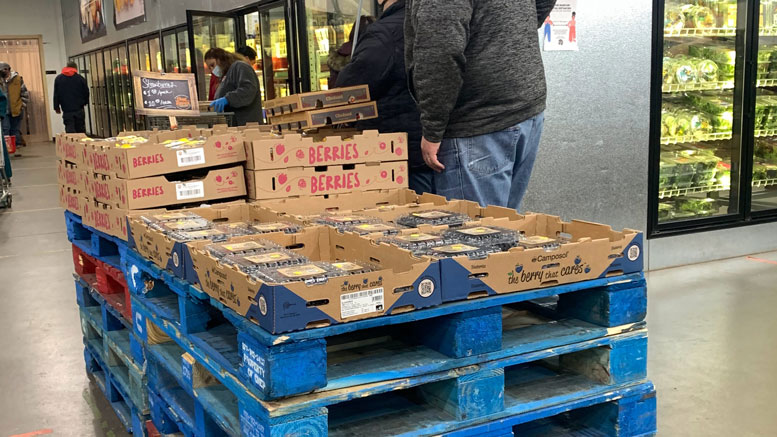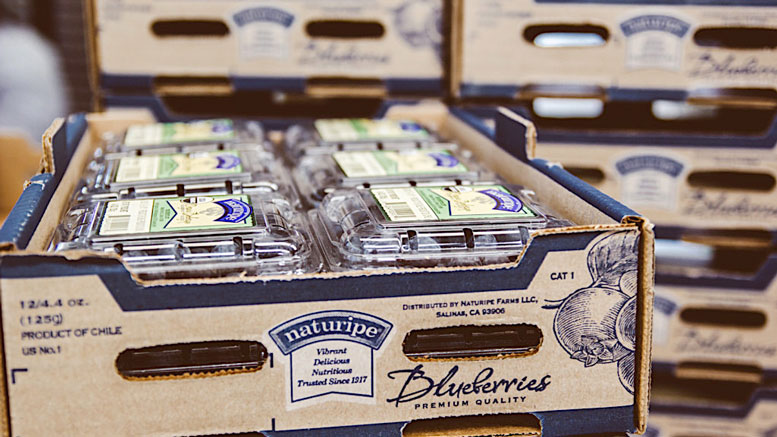Imports Make Blueberries Year-Round Favorites
February 15, 2023 | 8 min to read
Demand for blueberries is rising, prompting retailers to adopt aggressive merchandising strategies to sustain sales beyond the domestic season. Imports from countries like Mexico and Peru facilitate year-round availability, appealing particularly to health-conscious consumers. Highlighting blueberries through cross-merchandising, competitive pricing, and seasonal promotions can significantly drive sales. Retailers are encouraged to showcase blueberries in versatile applications, catering to changing consumer preferences, especially during colder months focused on baking and comfort foods.

Demand for blueberries is gaining, so aggressive merchandising can boost sales even after the domestic season winds down.
Originally printed in the January 2023 issue of Produce Business.
Imports have made blueberries a year-round staple for many U.S. consumers. With many, especially younger, consumers focused on healthier eating or boosting the proportion of plant-based foods in their meals, blueberries have a ready audience that may be coaxed into making them a more regular part of their diets.
Cross-merchandising and even signage suggestions on use can encourage shoppers to pair blueberries with yogurt for breakfast, smoothies for lunch and salads for dinner, and they can perk up any meal throughout the day.
Marc Goldman, produce director at Morton Williams Supermarkets, Bronx, NY, says blueberry promotions can be relatively effective in the U.S. and import seasons, even if imports do have one drawback, and it’s really not much of a difference, he says.
“The difference is the imported are normally a 6-ounce container. They don’t sell as well as pints. Also, in-season from the USA will outsell imported by a large amount.”
Still, he adds, “if the quality is good and the price is right, I will promote.”
At Bargain Grocery, Utica, NY, when blueberries roll in, they are merchandised with high visibility to prompt consumer attention. “We will do a center aisle display to highlight them,” says Mike Servello. “For a good price, they move very quickly.”
IMPORT GEOGRAPHY
The import season, with major volume coming from Mexico, Peru and Chile, now has more overlap with U.S. production, according to Tony Colonna, category manager, berries, at William J. Kopke Jr. Inc., Great Neck, NY.

PHOTO COURTESY BARGAIN GROCERY
“The South American season begins harvest in July and runs through March,” he says. “Mexico typically begins in August and runs through June. The overlap with U.S. production continues to expand. The most significant overlaps are in March/April and August/September.”
Imports to the United States are growing each year, and Colonna says they are seeing “significant growth” from Peru and Mexico.
At Naturipe, Salinas, CA, imported berries arrive from Chile, Peru, Uruguay, Argentina and Mexico. “Naturipe begins importing berries in September, and we typically wrap up around April or May,” says Jim Roberts, president of sales.
And acreage under cultivation is gaining abroad.
“Overall, import volume is up as well as acreage, specifically in Peru and Mexico,” says Helena Beckett, director of sales at Giddings Berries USA, the Monterey, CA-based subsidiary of Giddings Fruit. “We’re seeing acreage investment in countries that are closest to the U.S. market.”
“The key season for us is September through February. The Peruvian season overlaps with the end of the U.S./Canada season,” Beckett adds. “Peru and Chile are our primary import sources.”
Overlap is pronounced with the U.S. season, with imports expanding their timeframe.
“Imports from Peru are earlier and earlier. This season they started arriving in June/July, with significant volume in early September,” says Phil Rindone, director of berry sales at Pandol Brothers, Delano, CA. “This is due to a number of factors, including the downturn in the economies of Europe and Asia this year, as well as increased production in Peru. Mexican production occurs in two main stages, extending from late summer into May.”
He added that acreage under cultivation is growing, not only in key import origin regions such as Peru and Mexico, but also in other parts of the world.
At Naturipe, Roberts says availability and quality will be especially strong through October, November and early December, and FOB market pricing will look similar to last year during the peak periods of October through November.
“We are expecting to see lower volumes in December and early January as Peru winds down and with Chile running a couple weeks late at this time versus last year. In mid-January, we expect Chile to be in peak production and then for volumes from Mexico to pick up as we get into February and March,” Roberts adds.
The U.S. economy still is under pressure from inflation, so at least some effect on imported blueberries is expected.
“Inflationary pressures are affecting costs across the board,” Beckett says.
At A.J. Trucco, Bronx, NY., imports start with Peru and shift to Chile in January, says Tony Biondi, sales director. He notes the import volume is up compared to previous years, even if some cold weather kept the crop smaller than originally predicted. However, prices have made up for any shortcoming at harvest because of increased demand.
“Consumption of blueberries is up everywhere because of the health benefits,” he says.
For all intents and purposes, blueberries now are a year-round commodity, and Biondi says imports, and particularly Peru, where growers have embraced new varieties and growing conditions are just about ideal, is a top-flight source today.
HOW TO BOOST BLUEBERRIES
With extended expectations to find fruit, blueberries have enjoyed greater demand from consumers, Beckett says. As produce departments respond, good handling practices should be the basis of in-store merchandising.
“Blueberries should be merchandised in refrigeration, and ideally there is a conventional and organic option for consumers to choose from,” she notes. “Cross-merchandising with other berries makes sense, or a complementary item, as long as there is refrigeration.”
Basic merchandising is a family affair, and Biondi says positioning blueberries with other berries, particularly strawberries, is important in the import season when catching the attention of consumers, including kids.

PHOTO COURTESY NATURIPE
Pandol Brothers’ Rindone agrees blueberries can benefit from promotions that employ their extended family. So, retailers can get a lift from “berry patch” ads that promote several berries at once, and also presentations in large packs, including those at 18 and 24 ounces.
Biondi says that price promotions are important to drive and support blueberry sales across the entire calendar.
“Now is a great time to promote blueberries because the price is very reasonable,” he says, whether it’s a price cut off a pint, two for one, or buy one, get one free.
Although demand is increasing, produce departments can maintain the momentum by keeping imported blueberries on shoppers’ minds. “Blueberries used to be a feature item in the spring and summer, which aligned with the domestic production,” Kopke’s Colonna says. “With the significant volume increases from South America and Mexico, we are seeing promotional opportunities 12 months a year. Big packs have been more consistent throughout the year and that trend will continue.”
In fact, “January is a great month to promote import blueberries,” says Beckett. “There is strong supply from Chile and Peru, and consumers are focused on renewing their healthy eating habits following the holiday season. It’s a great time to capture organic sales, as consumer commitment to wellness is at a peak, and they are more likely to trade up in this time frame, and there is plenty of supply to support their renewed good habits.”
Retailers don’t have to change their basic merchandising strategy for blueberries when the domestic season gives way to the import selling timeframe.
“Retailers can promote both imported and domestic berries in the same ways,” Naturipe’s Roberts says. “With the berry category now being the largest category in produce, we recommend that our retailers create a fall berry patch in the produce section. This highlights the berries that are in season, including blueberries, all in one place. We also recommend that retailers spotlight all the benefits of blueberries: They’re packed full of antioxidants, they’re high in manganese, and they’re a great source of fiber, no matter where they come from.”
NEW NOTIONS
It can be a good idea to provide consumers with ideas for more uses, recipes and simple reminders that blueberries are a good addition to everything from breakfast cereal to ice cream sundaes to baked goods.
“Blueberries are great for snacking, baking, smoothies, etc.,” Colonna says. “Promotions for blues can include any and all of those applications. The promotions should reflect the time of the season. Around Thanksgiving/Christmas, promote them for holiday baking, etc.”
Blueberries have broad appeal, Beckett says, but consumers do shift cooking focus as the weather changes. So, the key to merchandising is what style of cooking is preferred in the import season, as cold and outdoor-oriented dishes give way to what is warm and comforting.

“Baking trends are strongest in the cooler months, and it is a great idea to promote baking with blueberries during the blueberry import season, which align with the fall/winter in the U.S.,” Beckett says.
Colonna says he and his colleagues are looking ahead with enthusiasm. “William H. Kopke Jr. Inc. anticipates a fantastic import blueberry season ahead. Promotional opportunities throughout the fall and winter are planned,” he says.
Given ongoing supply chain complications and general economic complications, imported blueberries will be under some degree of macro pressure.
“Costs have been increasing and we anticipate that trend to continue,” Colonna says. “It is impacting all aspects of the supply chain, all the way to the end consumer. The economic challenges will become more complicated as we navigate through the end of 2022 and into next year.”

